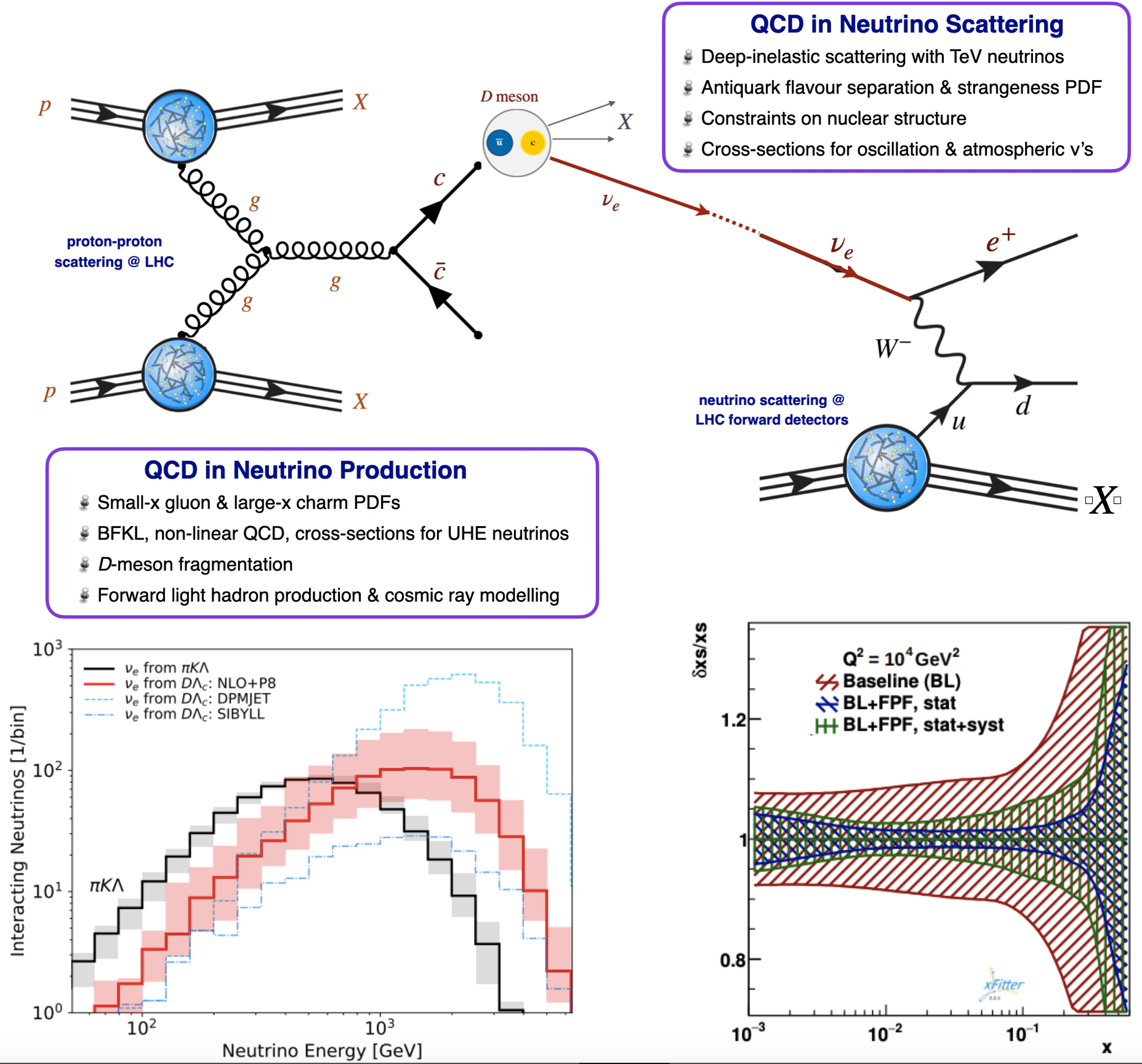Forward neutrinos produced in proton-proton collisions at the LHC and detected by the LHC experiments offer a broad palette of new avenues to further our understanding of the strong nuclear force, quantum chromodynamics (QCD). QCD studies with LHC neutrinos can be classifiedinto effects associated to neutrino production and those associated with neutrino scattering at the target detector. We describe each of them in turn.
The forward neutrino flux reaching the FPF is characterised by energies of up to several TeV, which correspond to the highest neutrino energies ever achieved in a laboratory environment. The high-intensity energetic beam can be deployed as a Deep-Inelastic Scattering (DIS) experiment to constrain the quark and gluon structure of protons and heavy nuclei. In terms of kinematic reach, neutrino DIS at LHC corresponds to similar center-of-mass energies as those to be achieved at the Electron-Ion Collider (EIC) but with a complementary sensitivity to hadron structure thanks to the neutrino charged-current interactions. Quantitative projections show that up to one million electron- and muon-neutrino DIS interactions within detector acceptance can be expected by the end of the HL-LHC data-taking period at the FPF experiments. Including FPF DIS projections into global (n)PDF analyses reveals a significant reduction of PDF uncertainties, in particular for strangeness and the up and down valence PDFs, enabling improved theoretical predictions for core processes at the HL -LHC, such as Higgs and weak gauge boson production. In this respect, the FPF effectively provides CERN with a "Neutrino-Ion Collider" without requiring modifications in its accelerator infrastructure.
This FPF neutrino flux arises from light and heavy hadron decays produced in the forward region of LHC collisions. Of particular interest for studies in perturbative QCD are neutrinos from D-meson decays, which dominate the high-energy spectrum of LHC neutrinos. The production of D-mesons in LHC collisions is dominated by gluon fusion and can be described using perturbative QCD in various schemes. Measurements of the neutrino flux at the FPF therefore provide access to both the very high-x and the very low-x regions of the colliding protons. The former regime provides information about open questions related to the high-x parton distribution functions (PDFs) and, in particular, intrinsic charm. The latter regime is sensitive to novel QCD production mechanisms, such as BFKL effects and non-linear dynamics, as well as the gluon PDF down to x ∼ 10^{−7}, well beyond the coverage of other experiments and providing key inputs for astroparticle physics. Specifically, constraints provided by LHC neutrinos on small-x QCD represent the only laboratory probes of a kinematic region which would be instrumental at a possible higher-energy proton-proton collider, such as the FCC 100 TeV, where even Higgs and electroweak cross-sections are sensitivity to this small-x region.
A specific example of new QCD phenomena that is expected to appear is gluon saturation. This effect causes a suppression of the gluon density at low-x and leads to a reduced flux of TeV- energy neutrinos at the FPF. In addition, charm hadron decays in extensive air showers produce the main background in searches for high-energy astrophysical neutrinos, namely the prompt neutrino flux. Measurements at the FPF will, therefore, also reduce the associated uncertainties of current measurements with IceCube and KM3NeT, as well as for future detectors, such as IceCube-Gen2.
Another important application of FPF measurements for QCD studies concerns data-driven cross-sections for neutrino and astroparticle physics. The interpretation of present and future neutrino experiments requires accurate theoretical predictions for neutrino-nucleus scattering rates. Neutrino structure functions can be reliably evaluated in the deep-inelastic scattering regime within the perturbative QCD (pQCD) framework, but at low momentum transfers inelastic structure functions are however affected by large uncertainties which distort event rate predictions for neutrino energies up to the TeV scale. FPF
measurements can constrain neutrino inelastic structure functions in the shallow region and hence inform current and future experiments focusing on oscillation and atmospheric neutrino physics.

